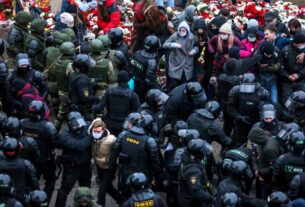Reports of shelling at Europe’s largest nuclear power plant in Russian-occupied Ukraine have reignited fears of nuclear disaster — but experts remain confident that the risk of a Chernobyl-like cataclysm is low.
The plant at Zaporizhzhia, which has been under the control of Moscow’s troops since March, was hit with several shelling attacks over the weekend.
Ukraine and Russia traded accusations for the strikes, with Ukraine saying a Russian attack damaged three radiation monitoring detectors and caused one plant employee to be hospitalized with shrapnel wounds.
News of the strikes quickly drew international condemnation, with U.N. Secretary-General António Guterres calling “any attack” on nuclear facilities “suicidal” and the head of the International Atomic Energy Agency Rafael Mariano Grossi urging both parties to “exercise the utmost restraint” to avoid a nuclear disaster.
Ukrainian President Volodymyr Zelenskyy immediately urged Western countries to hit Russia with new sanctions on its nuclear industry, echoing previous warnings of a Chernobyl-scale calamity.
“The world should not forget about Chernobyl and remember that the Zaporizhzhia [nuclear power plant] is the largest in Europe,” he said. “The Chernobyl disaster is an explosion in one reactor, the Zaporizhzhia is six power units.”
But experts say the situation at Zaporizhzhia — where 500 Russian soldiers and 50 pieces of heavy machinery, including tanks, are stationed, according to Ukraine — doesn’t warrant warnings of a Europe-wide disaster.
The risks from shelling are limited given the reactors are protected by up to 10 meters of concrete, according to Leon Cizelj, president of the European Nuclear Society. He estimated that only a barrage of targeted aerial bombings would be likely to breach the reactor walls.
An attack on spent fuel storage sites, he added, would have a limited effect, as any released radioactive material would only travel around 10 to 20 kilometers.
James Acton, co-director of the nuclear policy program at the Carnegie Endowment for International Peace, agreed that shelling is not the real risk, pointing to the vulnerability of the plant’s cooling systems instead.
“The right analogy here is Fukushima not Chernobyl,” he said.
Nuclear power plants are designed with multiple independent safety systems, including numerous grid connections and backup diesel generators. Zaporizhzhia also uses a spray pond for cooling, meaning hot water from inside the plant is sprayed into the air outside to lower its temperature.
These are “actually going to be relatively vulnerable because they have to be in contact with the outside world,” making them potential targets for attack, said Acton.
Both stressed that even in the worst case scenario — if the cooling systems fail, leading to a reactor meltdown — it would only cause serious damage at a local level. Cizelj estimated a 30-kilometer radius.
“It will be a tragedy for the local people,” he said, even if it would create no immediate casualties, but “for us in Europe … it would be a very unimportant event, in terms of consequences for health or anything else in the environment.”
So why are Russia and Ukraine accusing each other of shelling and emphasizing the risk of disaster?
“The idea of a nuclear accident is scary — it will get people’s attention — so it is a ready-made tool for this purpose” said John Erath, senior policy director at the Center for Arms Control and Non-Proliferation, a non-profit.
For Russia, it’s a way to “raise the stakes to increase [domestic] concerns … to highlight the importance of continuing the military operation,” he said.
It could also be a strategy to “play upon Western fears of a nuclear disaster and degrade Western will to provide additional military support to Ukraine,” according to an analysis from the Institute for the Study of War published Monday.
As for Ukraine, the aim is to build “public sympathy” around the captured plant, Erath said.
This article is part of POLITICO Pro
The one-stop-shop solution for policy professionals fusing the depth of POLITICO journalism with the power of technology
Exclusive, breaking scoops and insights
Customized policy intelligence platform
A high-level public affairs network



